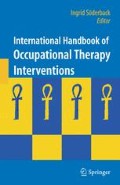Abstract
People with disabilities are dependent on or function best with adaptations to environments, which enable them to function optimally and perform daily activities. However, many of these adaptations would not be necessary if universal design was applied to environments as a standard. Outlined in seven principles, universal design may be applied to environments to improve everyday functioning. In so doing, universal design improves access for people with and without disabilities (Bowe, 2000; Burgstahler, 2001; McGuire et al., 2001).
Examples for application of universal design in occupational therapy environments and sessions are described. These principles may be used to maximize client access and intervention outcomes. Applications of universal design principles are consistent with occupational therapy values and assists OTs in meeting the therapeutic needs and potential of all our clients regardless of their disabilities or learning differences (Bowe, 2000; Burgstahler, 2001).
Access this chapter
Tax calculation will be finalised at checkout
Purchases are for personal use only
References
Bowe, F.G. (2000). Universal Design in Education. Westport, CT: Bergin and Garvey.
Burgstahler, S. (2001). Universal Design of Instruction. Seattle: DO-IT, University of Washington.
Canadian Association of Occupational Therapists. (1990). Position paper on the role of occupational therapy in adult physical dysfunction. Can J Occup Ther, 57(5), suppl 1–8.
Christiansen, C., and Baum, C., eds. (1997). Person-environment occupational performance. A conceptual model for practice. In: Occupational Therapy. Enabling Function and Well-Being, 2nd ed. Thorofare, NJ: Slack.
Law, M., Gaum, C.M., and Baptiste (2002). Occupation-Based Practice: Fostering Performance and Participation. Thorofare, NJ: Slack.
McGuire, J., Scott, S., and Shaw (2001). Principles of Universal Design for Instruction. Storrs, CT: Center on Postsecondary Education and Disability.
North Carolina State University, the Center for Universal Design D-492, 2008. The Principles of Universal Design. http://www.design.ncsu.edu/cud/about_ud/udprinciples.htm.
Author information
Authors and Affiliations
Editor information
Rights and permissions
Copyright information
© 2009 Springer Science+Business Media, LLC
About this chapter
Cite this chapter
Rickerson, N. (2009). Universal Design: Principles and Practice for People with Disabilities. In: Söderback, I. (eds) International Handbook of Occupational Therapy Interventions. Springer, New York, NY. https://doi.org/10.1007/978-0-387-75424-6_14
Download citation
DOI: https://doi.org/10.1007/978-0-387-75424-6_14
Publisher Name: Springer, New York, NY
Print ISBN: 978-0-387-75423-9
Online ISBN: 978-0-387-75424-6
eBook Packages: MedicineMedicine (R0)

